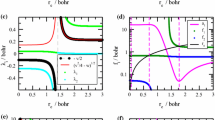Abstract
Some previous results of the present author are combined in order to develop a Hermitian version of the “Chemical Hamiltonian Approach.” In this framework the second quantized Born–Oppenheimer Hamiltonian is decomposed into one- and two-center components, if some finite basis corrections are omitted. (No changes are introduced into the one- and two-center integrals, while projective expansions are used for the three- and four-center ones, which become exact only in the limit of complete basis sets.) The total molecular energy calculated with this Hamiltonian can then presented as a sum of the intraatomic and diatomic energy terms which were introduced in our previous “chemical energy component analysis” scheme. The corresponding modified Hartree–Fock–Roothaan equations are also derived; they do not contain any three- and four-center integrals, while the non-empirical character of the theory is conserved. This scheme may be useful also as a “layer” in approaches like ONIOM.
Similar content being viewed by others
References
Mayer I (1983) Int J Quantum Chem 23:341
Ruedenberg K (1951) J Chem Phys 19:1433
Mayer I (1998) Int J Quantum Chem 70:41
Salvador P, Asturiol D, Mayer I (2006) J Comput Chem 27:1505
Mayer I (1983) Chem Phys Lett 97:270
Mayer I (2007) J Comput Chem 28:204
Mayer I (2012) Chem Phys Lett 544:83
Programs BORDER, NEWBORDER etc. http://occam.ttk.mta.hu
Mayer I (2000) Chem Phys Lett 332:381
Program APOST. http://occam.ttk.mta.hu
Mayer I (2006) Phys Chem Chem Phys 8:4630
Mayer I (2007) Faraday Discuss 135:439
Mayer I (2012) Phys Chem Chem Phys 14:337
Programs APEX4, ENPART, NEWENPART. http://occam.ttk.mta.hu
Maseras F, Morokuma K (1995) J Comput Chem 16:1170
Longuet-Higgins HC (1966) In: Löwdin P-O (ed) Quantum theory of atoms, molecules and the solid state. Academic Press, New York, p 105
Surján PR (1989) Second quantized approach to quantum chemistry. Springer, Berlin
Hamza A, Mayer I (2003) Theor Chem Acc 109:91
Author information
Authors and Affiliations
Corresponding author
Additional information
Dedicated to the 60th birthday of Professor Péter R. Surján.
Published as part of the special collection of articles “Festschrift in honour of Péter R. Surjan.”
Appendix: Derivation of Eq. (45)
Appendix: Derivation of Eq. (45)
When considering the integral approximations, we should stick to the [12|12] convention for the integrals permitting to distinguish the terms originating from the “bra”-s and “ket”-s, respectively; in the final formulae we have turned to the (11|22) convention more convenient in programming.
Systematizing the terms according to the centers of the orbitals involved, for the one-center matrix elements of matrix \({\mathbf{F}}^\sigma\) one has
Only the last sum of Eq. (48) contain three- or four-center integrals that need to be approximated, therefore we shall consider its terms in detail. At first, we substitute the approximations (6) in the first term of that sum:
Both subscripts of the coefficient \(A^{AC}_{\mu \lambda }\) in the first term are belonging to the diatomic fragment AC; as noted above, the intra-fragment blocks of the matrices \({\mathbf{A}}\) are unit-matrices; therefore, this coefficient reduces to the Kronecker delta \(\delta _{\mu \lambda }\). Similarly, in the second term \(A^{AB\dagger }_{\lambda \nu }=\delta _{\lambda \nu }\). Utilizing this we get:
In the followings we shall assume that we use real basis orbitals and orbital coefficients—as it is usually the case in the practice. Then \(D_{\tau \rho }=D_{\rho \tau }\), \(A^{AB\dagger }_{\eta \tau }= A^{AB}_{\tau \eta }\), \([\mu \rho |\lambda \eta ]=[\lambda \eta |\mu \rho ]\), and interchanging some summation indices we can conclude that the two sums are equal. Thus we have in the real case
The summation over \(\rho \in B;\ B\ne A\) in the right-hand side of Eq. (51) means that ρ runs over all the orbital indices, except those assigned to atom A; we may add and subtract the sum for the case \(\rho \in A\):
In the first term on the right-hand side, we can sum over ρ to get the “projected density matrix element” \(B^{AC}_{\tau \eta }\), while in the second term the coefficient \(A^{AC}_{\rho \eta }\) again reduces to the Kronecker delta \(\delta _{\rho \eta }\). Thus we get, changing the summation index C to B in the right-hand side:
The second sum just cancels the respective term in the third line of Eq. (48).
The second (exchange) term in the fourth line of Eq. (48) transforms analogously. However, in that case the two terms are not equal, as were in Eq. (50), and there is no full canceling of the second term in the third line of Eq. (48); instead the half of the respective terms in both second and third lines is canceled.
Rights and permissions
About this article
Cite this article
Mayer, I. Hermitian “chemical” Hamiltonian: an alternative ab initio method. Theor Chem Acc 134, 86 (2015). https://doi.org/10.1007/s00214-015-1682-y
Received:
Accepted:
Published:
DOI: https://doi.org/10.1007/s00214-015-1682-y




